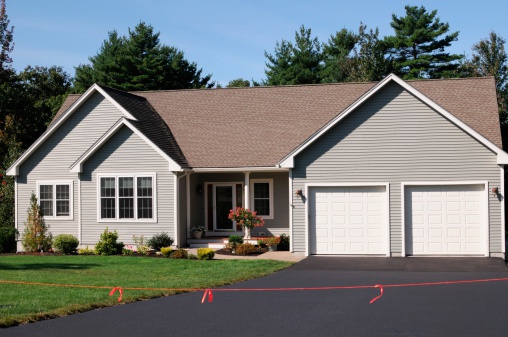Asphalt Sealcoating Things to Avoid: Not-To-Do List
There are many reasons why you should sealcoat your asphalt driveway. With the constant exposure to weather elements, oil and gas leaks, as well as frequent freeze and thaw cycles during the winter season, you must take care of your driveway if you want it to last long. A well taken care of asphalt driveway can last at least 20 years, with a maximum lifespan of 30 years. However, failing to do an annual inspection and maintenance like crack filling and sealcoating, you might be forced to repave your driveway a few years after its installation.
However, when it comes to asphalt sealcoating, it should be done once every 2 – 3 years, depending on the climate of your location and the volume of traffic that accesses your driveway. And, for your sealcoating to be effective, you must ensure that it’s done correctly from the word go. However, most people fail to observe this when sealcoating their driveways. This post will discuss what you must avoid during your sealcoating project. Let’s delve in!
Contents [hide]
Not cleaning your driveway before sealcoating
It’s common for asphalt to be covered by dust, debris, oil stains, or other substances that block any sealant you apply. To resolve this problem, it is recommended that you clean your driveway before applying sealant. For smaller driveways, pressure cleaning can be used. For larger driveways, truck-mounted equipment will do the trick. The toughest ones might need hand scrubbing but ensure that it’s done thoroughly because even a tiny bit of dirt leftover can destroy the overall results of your sealcoating project.
Leaving loose nails and screws on your driveway
This one should go without saying, but many people fail to observe this simple yet important step which leads to their failure in sealing their asphalt driveway correctly. You must remove any nails, screws, or debris that might damage your sealant. If a nail punctures the sealant as soon as it is applied, you won’t have a chance to correct it, and you will have to redo your work from the beginning, which can be both time-consuming and expensive.
Not cleaning oil spills on driveways with gravel
If you have a resin bound gravel driveway as part of your surface, this step is extra important for you, so pay attention! Before applying new asphalt sealcoating on top of gravel surfaces, wipe out any oil stains from these areas with a paper towel soaked in kerosene or mineral spirits before washing the area with a garden hose to remove residual chemicals. Existing oil stains that are not removed before sealcoating will set into the gravel and prevent your asphalt sealant from adhering to the surface.
Applying sealant in direct sunlight
Sealants can be applied only when it’s not too sunny or hot outside. Applying sealant in high-temperature conditions might lead to bubbles and blisters that you don’t want on your driveway. For best results, apply sealants at low temperatures (45°F – 85°F) for longer periods, such as during early morning or evening hours when the sun is down.
Failing to fill cracks and potholes properly
The Jacksonville experts from CSG Sealcoating say that you can either use hot asphalt or cold asphalt for crack filling. And the latter works best because it sets quickly, allowing you to apply sealant easier on top of it, whereas the former needs time to cure before applying sealant, which might cause you to miss your deadline. If you choose to use hot asphalt for this step, be sure that your driveway surface is cool to touch when sealing over top of it because if it’s too warm, there are chances that the heat remaining in it will cause bubbles in your new sealant. Also, make sure not to leave any cracks unfilled by using patching material mixed with gravel and sand, which should be applied until the edges of whichever area you are working on.
Using asphalt sealant on driveways that have been painted or coated
If your driveway has just been painted or coated within the last year, then it is important not to use an asphalt sealant because doing so will remove the paint immediately and can damage other types of coatings if they’re applied over it afterward causing you unnecessary headaches in maintaining your driveway surface.
Forgetting to apply a primer on top of new paint
Applying a layer of primer on top of freshly-painted surfaces before applying a sealant will ensure better adhesion between all layers. This helps increase the longevity and durability while protecting it from UV rays, oxidation, acid rain, and other external factors that normally break down asphalt.
Applying sealant on wet surfaces
Asphalt driveway sealing can be done when the surface has dried after rain or dew, but if it’s still damp, applying a sealant as soon as it dries up might cause bubbles to form underneath, which will become visible later on after drying even further.
To avoid this from happening, you should wait for at least 12 to 24 hours before starting your work. Another thing to remember is that you need to apply a special anti-skid additive on top of fresh asphalt and curing concrete. This step would also require you to wait for at least 12 hours before continuing your asphalt driveway sealing project.
Working too fast without giving time for the sealant to dry sufficiently
For proper results, allow your asphalt driveway sealant to dry for about 24 hours before you start walking on it, vehicle traffic, or any other activity that could damage it. If you can wait longer, do so but don’t apply a second layer of sealant until the first one has fully dried up because some chemicals will prevent new layers from being adhered properly onto existing ones.




